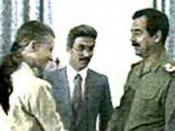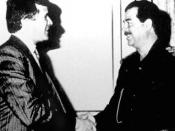In March of 2003 the United States army, backed by the British forces, led the "invasion of Iraq", under the pretence that the nation of Iraq was developing a "weapons of mass destruction" program. Iraq, led by its egoistic dictator Saddam Hussein, did not comply with the United States and did not surrender to the American forces, despite its overwhelming presence in the Iraqi border. After trying to lead the Iraqi military against the American forces from a secret hideout, Saddam Hussein was eventually captured and killed against his own will. Even though the theories of force, as presented by Art and Schelling, would've suggested a premature surrender by Saddam Hussein and his armies, the Iraqi dictator is fueled by an egotistic personality, a nationalistic pride and a glory seeking imagination that would never enable him to agree and surrender to the overpowering authority of the American military in his land.
Robert J. Art has clear theories on force and how they affect international diplomacy. He divides force into four functions: defense, deterrence, compellence and swaggering. Each of them has their own characteristics and during the Iraq invasion, the United States army used more of a "compellent" force. As Art explains in "The Uses of Force," it is "the deployment of military power to be able to stop an adversary from doing something that he has already undertakenâ¦" In the case of the Iraqi invasion, the United States tried to stop Saddam Hussein from operating a "weapons of mass destruction" program. Analyzing Hussein's military activity before the United States invasion, his use of military, pertained more to a "swaggering" force, in which he aimed to enhance the national pride of his people to ultimately satisfy his personal ambitions. It is no secret that Saddam Hussein was...


